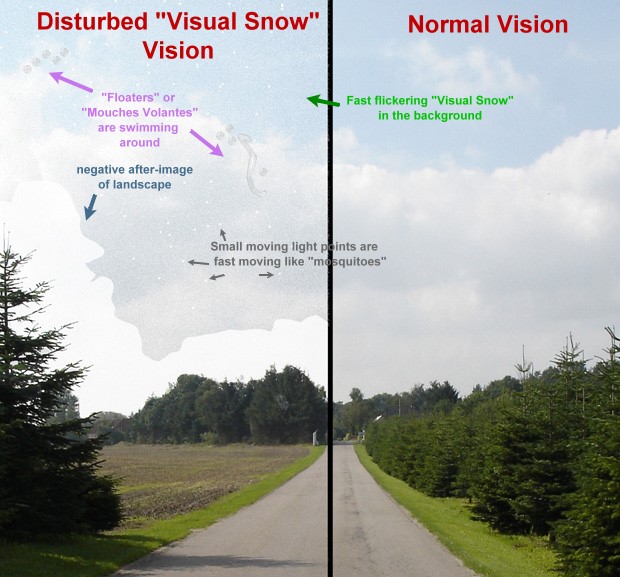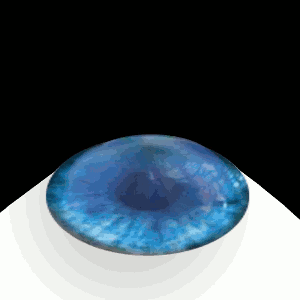|
Nyctalopia
Nyctalopia (; ), also called night-blindness, is a condition making it difficult or impossible to see in relatively low light. It is a symptom of several eye diseases. Night blindness may exist from birth, or be caused by injury or malnutrition (for example, vitamin A deficiency). It can be described as insufficient adaptation to darkness. The most common cause of nyctalopia is retinitis pigmentosa, a disorder in which the rod cells in the retina gradually lose their ability to respond to the light. Patients with this genetic condition have progressive nyctalopia and eventually, their daytime vision may also be affected. In X-linked congenital stationary night blindness, from birth the rods either do not work at all, or work very little, but the condition does not get worse. Another cause of night blindness is a deficiency of retinol, or vitamin A1, found in fish oils, liver and dairy products. The opposite problem, the inability to see in bright light, is known as ''hemeralopia ... [...More Info...] [...Related Items...] OR: [Wikipedia] [Google] [Baidu] |
Vitamin A Deficiency
Vitamin A deficiency (VAD) or hypovitaminosis A is a lack of vitamin A in blood and tissues. It is common in poorer countries, especially among children and women of reproductive age, but is rarely seen in more developed countries. Nyctalopia (night blindness) is one of the first signs of VAD, as the vitamin has a major role in phototransduction. Xerophthalmia, keratomalacia, and complete blindness can follow if the deficiency is more severe. Vitamin A deficiency is the world's leading cause of preventable childhood blindness, and is critical to achieving Millennium Development Goal 4 to reduce child mortality. About 250,000 to 500,000 malnourished children in the developing world go blind each year from a deficiency of vitamin A, around half of whom die within a year of becoming blind. The United Nations Special Session on Children in 2002 set a goal of the elimination of VAD by 2010. The prevalence of night blindness due to VAD is also high among pregnant women in many develop ... [...More Info...] [...Related Items...] OR: [Wikipedia] [Google] [Baidu] |
Visual Snow
Visual snow syndrome (VSS) is an uncommon neurological condition in which the primary symptom is that affected individuals see persistent flickering white, black, transparent, or coloured dots across the whole visual field. Other common symptoms are palinopsia, enhanced entoptic phenomena, photophobia, and headaches. The condition is typically always present and has no known cure, as viable treatments are still under research. Migraine and tinnitus are common comorbidities and are both associated with a more severe presentation of the syndrome. The cause of the syndrome is unclear. The underlying mechanism is believed to involve excessive excitability of neurons in the right lingual gyrus and left anterior lobe of cerebellum. Another hypothesis proposes that visual snow syndrome could be a type of thalamocortical dysrhythmia and may involve the thalamic reticular nucleus (TRN). A failure of inhibitory action from the TRN to the thalamus may be the underlying cause for inabilit ... [...More Info...] [...Related Items...] OR: [Wikipedia] [Google] [Baidu] |
Vitamin A Deficiency
Vitamin A deficiency (VAD) or hypovitaminosis A is a lack of vitamin A in blood and tissues. It is common in poorer countries, especially among children and women of reproductive age, but is rarely seen in more developed countries. Nyctalopia (night blindness) is one of the first signs of VAD, as the vitamin has a major role in phototransduction. Xerophthalmia, keratomalacia, and complete blindness can follow if the deficiency is more severe. Vitamin A deficiency is the world's leading cause of preventable childhood blindness, and is critical to achieving Millennium Development Goal 4 to reduce child mortality. About 250,000 to 500,000 malnourished children in the developing world go blind each year from a deficiency of vitamin A, around half of whom die within a year of becoming blind. The United Nations Special Session on Children in 2002 set a goal of the elimination of VAD by 2010. The prevalence of night blindness due to VAD is also high among pregnant women in many develop ... [...More Info...] [...Related Items...] OR: [Wikipedia] [Google] [Baidu] |
Adaptation (eye)
In visual physiology, adaptation is the ability of the retina of the eye to adjust to various levels of light. Natural night vision, or scotopic vision, is the ability to see under low-light conditions. In humans, rod cells are exclusively responsible for night vision as cone cells are only able to function at higher illumination levels. Night vision is of lower quality than day vision because it is limited in resolution and colors cannot be discerned; only shades of gray are seen. In order for humans to transition from day to night vision they must undergo a dark adaptation period of up to two hours in which each eye adjusts from a high to a low luminescence "setting", increasing sensitivity hugely, by many orders of magnitude. This adaptation period is different between rod and cone cells and results from the regeneration of photopigments to increase retinal sensitivity. Light adaptation, in contrast, works very quickly, within seconds. Efficiency The human eye can functio ... [...More Info...] [...Related Items...] OR: [Wikipedia] [Google] [Baidu] |
Cataract
A cataract is a cloudy area in the lens of the eye that leads to a decrease in vision. Cataracts often develop slowly and can affect one or both eyes. Symptoms may include faded colors, blurry or double vision, halos around light, trouble with bright lights, and trouble seeing at night. This may result in trouble driving, reading, or recognizing faces. Poor vision caused by cataracts may also result in an increased risk of falling and depression. Cataracts cause 51% of all cases of blindness and 33% of visual impairment worldwide. Cataracts are most commonly due to aging but may also occur due to trauma or radiation exposure, be present from birth, or occur following eye surgery for other problems. Risk factors include diabetes, longstanding use of corticosteroid medication, smoking tobacco, prolonged exposure to sunlight, and alcohol. The underlying mechanism involves accumulation of clumps of protein or yellow-brown pigment in the lens that reduces transmission of li ... [...More Info...] [...Related Items...] OR: [Wikipedia] [Google] [Baidu] |
Choroideremia
Choroideremia (; CHM) is a rare, X-linked recessive form of hereditary retinal degeneration that affects roughly 1 in 50,000 males. The disease causes a gradual loss of vision, starting with childhood night blindness, followed by peripheral vision loss and progressing to loss of central vision later in life. Progression continues throughout the individual's life, but both the rate of change and the degree of visual loss are variable among those affected, even within the same family. Choroideremia is caused by a loss-of-function mutation in the ''CHM'' gene which encodes Rab escort protein 1 (REP1), a protein involved in lipid modification of Rab proteins. While the complete mechanism of disease is not fully understood, the lack of a functional protein in the retina results in cell death and the gradual deterioration of the retinal pigment epithelium (RPE), photoreceptors and the choroid. As of 2019, there is no treatment for choroideremia; however, retinal gene therapy clinical ... [...More Info...] [...Related Items...] OR: [Wikipedia] [Google] [Baidu] |
Hemeralopia
Hemeralopia (from Greek ''ημέρα'' hemera, "day", and ''αλαός'' alaos, "blindness") is the inability to see clearly in bright light and is the exact opposite of nyctalopia (night blindness), the inability to see clearly in low light. Hemera was the Greek goddess of day, and Nyx was the goddess of night. However, it has been used in an opposite sense by many non-English-speaking doctors. It can be described as insufficient adaptation to bright light. It is also called "heliophobia" and "day blindness". In hemeralopia, daytime vision gets worse, characterised by photoaversion (dislike/avoidance of light) rather than photophobia (eye discomfort/pain in light), which is typical of inflammations of eye. Nighttime vision largely remains unchanged due to the use of rods as opposed to cones (during the day), which are affected by hemeralopia and in turn degrade the daytime optical response. Hence, many patients feel they see better at dusk than in daytime. Causes Hemeralopia i ... [...More Info...] [...Related Items...] OR: [Wikipedia] [Google] [Baidu] |
P360 Onderdendam Goed Nachtzicht Ns Nachtblind (russian: Р-36, link=no), with a Cyrillic instead of a Latin P.
{{Letter-NumberCombDisambig ...
P36 or P-36 may refer to: Vessels * , a ship of the Argentine Navy * , a P-class sloop of the Royal Navy * , a submarine of the Royal Navy * , a corvette of the Indian Navy Other uses * Curtiss P-36 Hawk, an American fighter aircraft * Papyrus 36, a biblical manuscript * Petrobras 36, a collapsed oil platform * Phosphorus-36, an isotope of phosphorus * Soviet locomotive class P36, a steam locomotive See also * R-36 (missile) The R-36 (russian: Р-36) is a family of intercontinental ballistic missiles (ICBMs) and space launch vehicles (Tsyklon) designed by the Soviet Union during the Cold War. The original R-36 was deployed under the GRAU index 8K67 and was given the ... [...More Info...] [...Related Items...] OR: [Wikipedia] [Google] [Baidu] |
Myopia
Near-sightedness, also known as myopia and short-sightedness, is an eye disease where light focuses in front of, instead of on, the retina. As a result, distant objects appear blurry while close objects appear normal. Other symptoms may include headaches and eye strain. Severe near-sightedness is associated with an increased risk of retinal detachment, cataracts, and glaucoma. The underlying mechanism involves the length of the eyeball growing too long or less commonly the lens being too strong. It is a type of refractive error. Diagnosis is by eye examination. Tentative evidence indicates that the risk of near-sightedness can be decreased by having young children spend more time outside. This decrease in risk may be related to natural light exposure. Near-sightedness can be corrected with eyeglasses, contact lenses, or a refractive surgery. Eyeglasses are the easiest and safest method of correction. Contact lenses can provide a wider field of vision, but are associated with ... [...More Info...] [...Related Items...] OR: [Wikipedia] [Google] [Baidu] |
LASIK
LASIK or Lasik (''laser-assisted in situ keratomileusis''), commonly referred to as laser eye surgery or laser vision correction, is a type of refractive surgery for the correction of myopia, hyperopia, and an actual cure for astigmatism, since it is in the cornea. LASIK surgery is performed by an ophthalmologist who uses a laser or microkeratome to reshape the eye's cornea in order to improve visual acuity. For most people, LASIK provides a long-lasting alternative to eyeglasses or contact lenses. LASIK is very similar to another surgical corrective procedure, photorefractive keratectomy (PRK), and LASEK. All represent advances over radial keratotomy in the surgical treatment of refractive errors of vision. For patients with moderate to high myopia or thin corneas which cannot be treated with LASIK and PRK, the phakic intraocular lens is an alternative. As of 2018, roughly 9.5 million Americans have had LASIK and, globally, between 1991 and 2016, more than 40 million proced ... [...More Info...] [...Related Items...] OR: [Wikipedia] [Google] [Baidu] |
Xerophthalmia
Xerophthalmia (from Ancient Greek "xērós" (ξηρός) meaning "dry" and "ophthalmos" (οφθαλμός) meaning "eye") is a medical condition in which the eye fails to produce tears. It may be caused by vitamin A deficiency, which is sometimes used to describe that condition, although there may be other causes. Xerophthalmia caused by a severe vitamin A deficiency is described by pathologic dryness of the conjunctiva and cornea. The conjunctiva becomes dry, thick and wrinkled. The first symptom is poor vision at night. If untreated, xerophthalmia can lead to dry eye syndrome, corneal ulceration, and ultimately to blindness as a result of corneal and retinal damage. Xerophthalmia usually implies a destructive dryness of the conjunctival epithelium due to dietary vitamin A deficiency—a rare condition in developed countries, but still causing much damage in developing countries. Other forms of dry eye are associated with aging, poor lid closure, scarring from a previous inj ... [...More Info...] [...Related Items...] OR: [Wikipedia] [Google] [Baidu] |


_PHIL_4284_lores.jpg)
